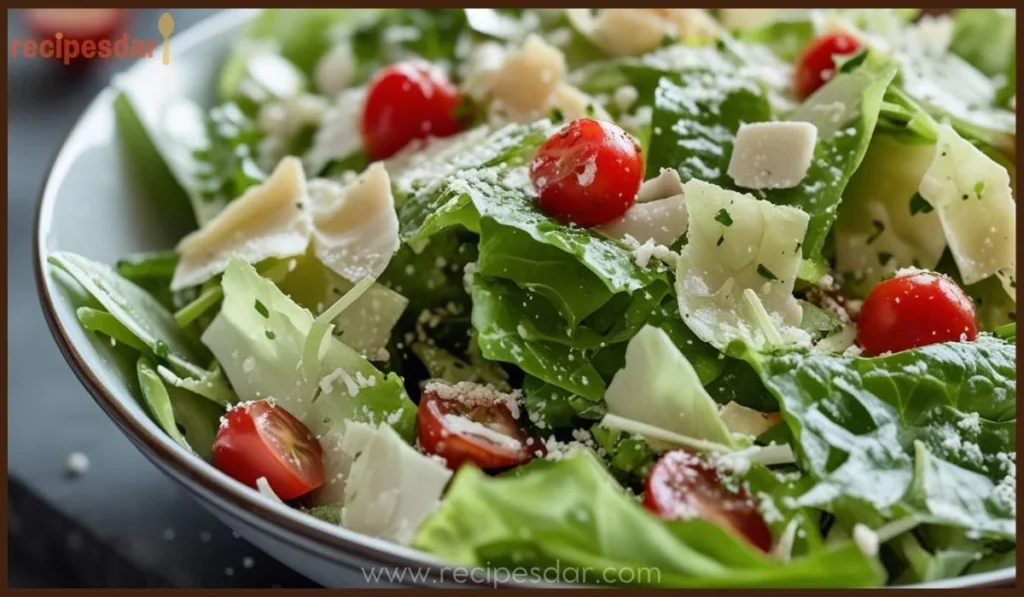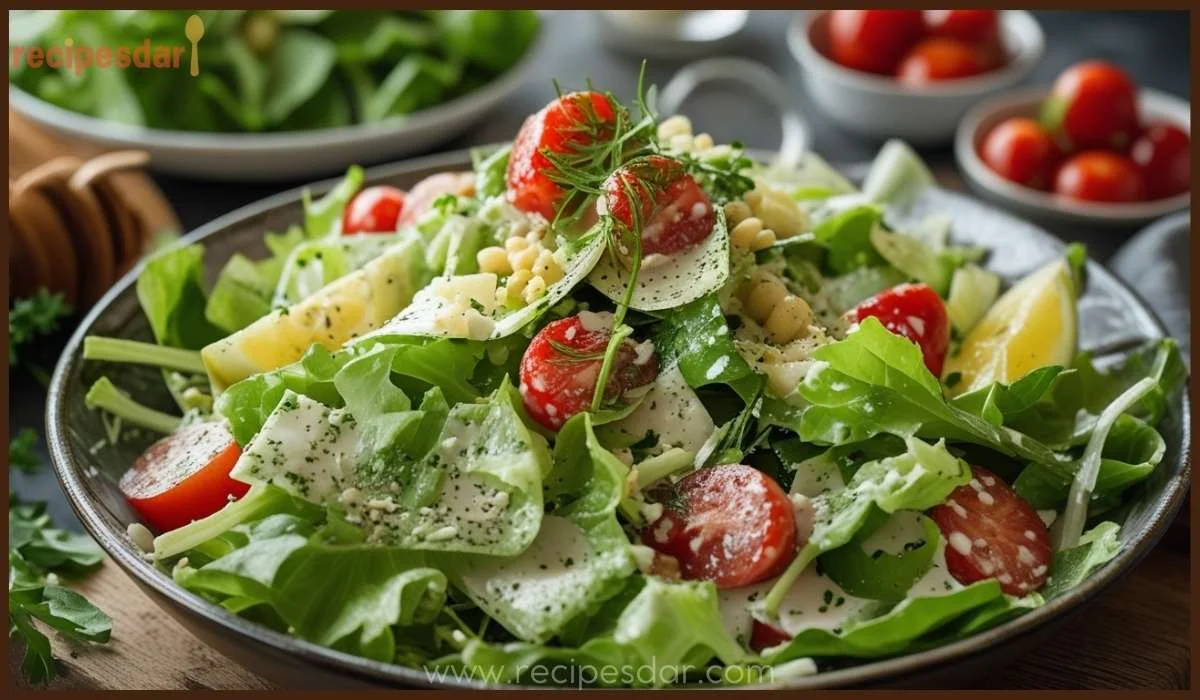The Caesar salad is a culinary classic celebrated for its crisp romaine lettuce, crunchy croutons, and creamy, tangy dressing. This iconic dish has earned its place in kitchens and restaurants worldwide, thanks to its perfect balance of simplicity and bold flavors. Whether served as a light starter or transformed into a hearty meal, the Caesar salad continues to captivate food lovers across the globe.
In this comprehensive guide, we’ll explore the fascinating history of the Caesar salad, provide detailed instructions for crafting the perfect dish, and introduce creative variations to suit every palate. To delve further into its origins, visit History of Caesar Salad for a deep dive into the story behind this iconic dish.
The History of Caesar Salad
The Caesar salad has a history as rich as its flavor. Created in 1924 by Cesare Cardini, an Italian-born restaurateur, it was born out of necessity during a busy Fourth of July weekend. Running low on supplies, Cardini combined romaine lettuce, Parmesan cheese, croutons, olive oil, coddled eggs, garlic, Worcestershire sauce, and lemon juice into a single dish. The result was a refreshing salad tossed tableside, which diners adored for its simplicity and bold flavors.
Its popularity soared when Hollywood celebrities visiting Tijuana shared stories about the salad, spreading its fame across California. Over time, the Caesar salad became a global phenomenon. Even today, chefs experiment with its core ingredients to create exciting variations while staying true to its origins. For more about its remarkable journey, check out History of Caesar Salad.

Essential Ingredients for Caesar Salad
The beauty of the Caesar salad lies in its reliance on high-quality, simple ingredients. Each component plays a vital role in creating the dish’s distinctive taste and texture.
Core Ingredients
- Romaine Lettuce: Provides the perfect base with its crisp texture and subtle bitterness.
- Parmesan Cheese: Offers a nutty, sharp flavor that enhances the salad’s depth.
- Croutons: Add crunch and soak up the creamy dressing.
- Caesar Dressing: Blends olive oil, garlic, coddled eggs, Worcestershire sauce, and lemon juice into a creamy, tangy sauce.
To elevate your salad, consider making croutons at home. Toss bread cubes with olive oil, garlic, and herbs, then bake until golden. For a step-by-step guide, visit Homemade Croutons Guide.
Crafting Caesar Dressing from Scratch
The dressing is the soul of the Caesar salad. Making it at home not only guarantees authenticity but also enhances the salad’s flavor.
Classic Caesar Dressing Recipe
- Ingredients:
- 2 large egg yolks (coddled)
- 2 garlic cloves
- 1 teaspoon Worcestershire sauce
- 1 tablespoon Dijon mustard
- 2 tablespoons fresh lemon juice
- ½ cup olive oil
- ¼ cup grated Parmesan cheese
- Instructions:
- Blend garlic, lemon juice, Dijon mustard, and Worcestershire sauce in a blender or food processor.
- Slowly add olive oil while blending to achieve a smooth emulsion.
- Mix in Parmesan cheese for a tangy finish.
If you prefer a lighter version, substitute yogurt for egg yolks. Alternatively, plant-based eaters can try a Vegan Caesar Dressing Recipe made with tahini and nutritional yeast.

Perfecting Your Caesar Salad
Step 1: Prepare the Lettuce
To ensure maximum freshness, wash and dry romaine leaves thoroughly. Tearing the leaves into bite-sized pieces helps with even distribution of dressing and toppings.
Step 2: Assemble Your Salad
Start by tossing the lettuce with a generous amount of Caesar dressing until evenly coated. Next, sprinkle croutons and Parmesan cheese over the top. Finally, garnish with additional cheese shavings and cracked black pepper for a sophisticated finish.
Step 3: Customize with Additions
If you’re serving the salad as a main course, consider adding proteins like grilled chicken, shrimp, or steak. This not only boosts the nutritional value but also makes the salad more satisfying.
Creative Caesar Salad Variations
The versatility of the Caesar salad lends itself to endless customization. Here are some exciting variations:
Protein Options
- Grilled Chicken Caesar Salad: Adds lean protein for a filling meal.
- Shrimp Caesar Salad: Pairs tangy dressing with succulent seafood.
- Steak Caesar Salad: A hearty, gourmet twist on the classic recipe.
Dietary-Friendly Choices
- Vegan Caesar Salad: Replace traditional dressing with plant-based alternatives and use vegan Parmesan.
- Gluten-Free Caesar Salad: Swap croutons for roasted chickpeas or toasted seeds.
Flavor Innovations
- Spicy Caesar Salad: Add heat with red chili flakes or a splash of hot sauce.
- Mediterranean Caesar Salad: Incorporate sun-dried tomatoes, olives, and feta cheese for a bold twist.
FAQs About Caesar Salad
What does the original Caesar salad have?
The original Caesar salad consists of romaine lettuce, freshly made croutons, Parmesan cheese, coddled eggs, olive oil, Worcestershire sauce, garlic, and fresh lemon juice. Anchovies were not part of Cesare Cardini’s original recipe, though they are now commonly included.
How do you make Gordon Ramsay’s Caesar salad?
Gordon Ramsay’s Caesar salad elevates the classic with gourmet touches. He often uses a rich dressing made from anchovies, Parmesan, Dijon mustard, garlic, and olive oil, and adds creative twists like pancetta crisps or poached eggs for added flavor and texture.
Why does Caesar salad taste so good?
The Caesar salad is beloved for its balance of flavors and textures. The creamy, tangy dressing complements the crisp lettuce, while the croutons add crunch. Parmesan cheese enhances the umami, creating a dish that satisfies multiple taste preferences.
Which ingredient is not commonly found in a Caesar salad?
Ingredients like tomatoes, cucumbers, or bell peppers are not typically part of a classic Caesar salad. These are sometimes added in modern adaptations but deviate from the original recipe.
Do all Caesar dressings have anchovies?
Not all Caesar dressings include anchovies. While they are a key ingredient in many recipes for their umami flavor, some versions use Worcestershire sauce or omit anchovies entirely to accommodate preferences or dietary restrictions.
Why does Caesar salad have raw egg?
Coddled eggs are traditionally used in Caesar salad dressing to create a rich, creamy emulsion. They help bind the olive oil and other ingredients, giving the dressing its signature texture.
Why can you eat mayonnaise but not raw eggs?
Mayonnaise is made from pasteurized eggs, which are heat-treated to eliminate bacteria like salmonella. Raw eggs in Caesar salad dressing may not always be pasteurized, so precautions are necessary when consuming them.
How long does Caesar dressing without egg last in the fridge?
A Caesar dressing without egg can last up to 7–10 days in the refrigerator if stored in an airtight container. Its longevity depends on the freshness of the other ingredients, especially dairy-based components.
Why is Caesar salad fishy?
The “fishy” flavor in Caesar salad often comes from anchovies, which are a common ingredient in the dressing. Anchovies add a savory umami depth, though they can be omitted or substituted if the flavor is too strong for some palates.
Serving Suggestions
The Caesar salad is versatile enough to serve as a standalone dish or as part of a larger meal. For a complete experience, consider pairing it with:
- Soups: Creamy tomato or French onion soup enhances the salad’s tangy dressing.
- Breads: Garlic bread or a warm baguette complements the crispness of the lettuce.
- Drinks: Enjoy with sparkling water or a crisp white wine for a refreshing contrast.
Conclusion: The Timeless Appeal of Caesar Salad
The Caesar salad stands as a testament to the beauty of culinary simplicity combined with bold flavors. Its history, rooted in the ingenuity of Cesare Cardini during a busy holiday weekend in Tijuana, reflects the power of creativity and resourcefulness. What began as a humble combination of romaine lettuce, Parmesan cheese, croutons, and a creamy dressing has evolved into a global phenomenon beloved by food enthusiasts everywhere.
Central to its enduring appeal is the Caesar salad’s versatility. Its classic recipe, with its crisp textures and tangy dressing, offers a foundation that can be adapted to countless variations. From pairing it with hearty dishes like Chicken Noodle Soup to experimenting with vegan or gluten-free alternatives, the possibilities are endless. Creative brunch options, such as Perfect French Toast alongside Caesar salad, provide even more ways to enjoy this dish.
Beyond its versatility, the Caesar salad holds a cultural significance that transcends its ingredients. It has graced the tables of fine dining establishments, family dinners, and casual gatherings, embodying both sophistication and accessibility. Its presence in global cuisine highlights its universal appeal, connecting people across cultures through shared flavors and traditions.
As you explore the art of making , embrace the opportunity to experiment with creative twists and personal touches. Whether you stick to the traditional recipe or craft a bold new variation, the Caesar salad remains a timeless dish that brings people together. Its rich history, simple elegance, and culinary adaptability ensure that it will continue to be a cherished favorite for generations to come.

